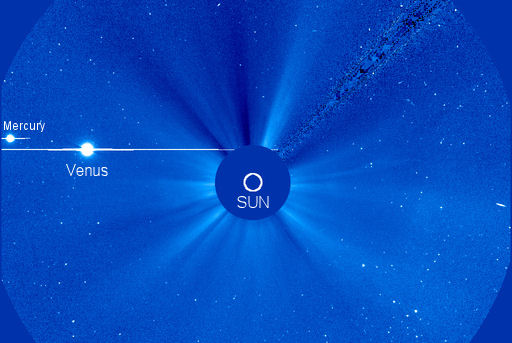VENUS PASSES MERCURY, APPROACHES THE SUN: Venus is approaching the sun in advance of the June 5th Transit of Venus. From here on Earth, the second planet has become difficult to see wrapped in bright sunlight. The Solar and Heliospheric Observatory, however, has no such trouble. SOHO's onboard coronagrah blocks the glare to reveal planets otherwise invisible:
A 24-hour movie shows that Mercury is exiting stage left as Venus plunges deeper into sunlight. Updated images may be found here.
Amateur astronomers who manage to locate Venus in broad daylight will find that the planet has turned into a delightfully slender crescent. This is happening because Venus is turning its nightside to Earth, with only a sliver of reflected sunlight still shining over the planet's limb.
The crescent could soon become a ring. When Venus is less than few degrees away from the sun, the horns of the crescent sometimes reach around and touch, producing a complete annulus. The effect is caused by particles in upper layers of Venus's atmosphere which scatter sunlight around the circumference of the planet. The ring is very difficult to observe, and often only black-belt astrophotographers are able to record the phenomenon.
Keep an eye on SpaceWeather's realtime photo gallery to see how Venus shape-shifts in the days ahead:

![]()
Solar wind
speed: 346.3 km/sec
density: 3.9 protons/cm3
explanation | more data
Updated: Today at 1556 UT
![]()
X-ray Solar Flares
6-hr max: B5 1500 UT Jun02
24-hr: C2 0105 UT Jun02
explanation | more data
Updated: Today at: 1500 UT
![]()
![]()
![]()
Daily Sun: 02 Jun 12
![]()
![]()
The sunspot number is increasing, setting an active stage for the June 5th Transit of Venus. Credit: SDO/HMI
![]()
![]()
![]()
Sunspot number: 151
What is the sunspot number?
Updated 01 Jun 2012
Spotless Days
Current Stretch: 0 days
2012 total: 0 days (0%)
2011 total: 2 days (<1%)
2010 total: 51 days (14%)
2009 total: 260 days (71%)
Since 2004: 821 days
Typical Solar Min: 486 days
Updated 01 Jun 2012
The Radio Sun
10.7 cm flux: 117 sfu
explanation | more data
Updated 01 Jun 2012
![]()
![]()
![]()
Current Auroral Oval:
![]()
Switch to: Europe, USA, New Zealand, Antarctica
Credit: NOAA/POES
![]()
![]()
![]()
Planetary K-index
Now: Kp= 2 quiet
24-hr max: Kp= 2 quiet
explanation | more data
![]()
Interplanetary Mag. Field
Btotal: 8.9 nT
Bz: 5.1 nT south
explanation | more data
Updated: Today at 1556 UT
![]()
![]()
![]()
Coronal Holes: 02 Jun 12
![]()
![]()
A large coronal hole is emerging over the sun's eastern limb. Solar wind flowing from the opening should reach Earth on June 5-7. Credit: SDO/AIA.





